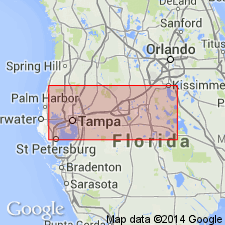
- Usage in publication:
-
- Tampa formation
- Modifications:
-
- Named
- Dominant lithology:
-
- Limestone
- AAPG geologic province:
-
- South Florida province
Summary:
Named for Tampa, Hillsborough Co., FL. Around many of the bays in this region there is a phase or stage of the Miocene, which for convenience may be called Tampa formation. "The unit is so thick that the influence of the underlying Eocene is not felt."
Source: GNU records (USGS DDS-6; Reston GNULEX).
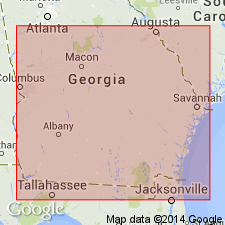
- Usage in publication:
-
- Tampa Limestone
- Modifications:
-
- Areal extent
- AAPG geologic province:
-
- South Florida province
Summary:
Author here formally proposes that use of name Tampa be abandoned in GA. Dolomitic deposits formerly called Tampa are included in the Chattahoochee, while phosphatic, argillaceous, sandy carbonates at base of Miocene in southern and eastern GA are included in the Parachucla Formation. Tampa occurs only in the Tampa Bay area of FL.
Source: GNU records (USGS DDS-6; Reston GNULEX).
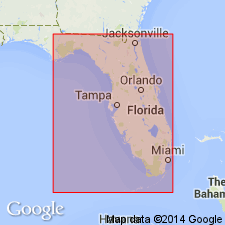
- Usage in publication:
-
- Tampa Member
- Modifications:
-
- Revised
- Reference
- AAPG geologic province:
-
- South Florida province
Summary:
Tampa is here reduced from formational to member rank and assigned to the Arcadia Formation of the Hawthorn Group. The change in status is based on its limited areal extent and its lithologic similarities and relationships with the remainder of the Arcadia as redefined in this paper. The Tampa is predominantly a subsurface unit, cropping out only in the Tampa area. A reference section is designated in core W-15166 (Bradenton R.O.M.P. TR7-1, W1/4 sec. 26, T35S, R17E, Manatee Co). Interval is between -285 ft (-87 m) and -423 ft (-129 m). Unit conformably overlies the Nocatee Member (new name) where both are present, or unconformably overlies the "Suwannee" Limestone where the Tampa forms the base of the Arcadia. Throughout most of its extent, the unit underlies carbonates of the undifferentiated Arcadia. A maximum thickness of 82 m occurs in core W-14882, Sarasota Co. Thickness averages 30.5 m. According to Huddlestun (1984, pers. commun.), the Tampa equates with part of the Parachucla Formation in GA, straddling the Oligocene-Miocene boundary. Hunter (1984, pers. commun.) believes that much of the Tampa as defined in this paper is older than the original type Tampa. Unit is also correlated with part of the Penney Farms Formation (new name) of north FL. Age of the base of the Arcadia in this paper is stated as early Miocene, hence an early Miocene age is inferred for the Tampa.
Source: GNU records (USGS DDS-6; Reston GNULEX).
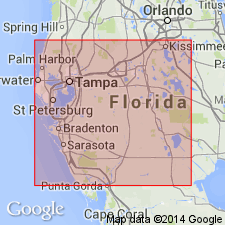
- Usage in publication:
-
- Tampa Member*
- Modifications:
-
- Overview
- AAPG geologic province:
-
- Florida platform
Summary:
In the Land-pebble district and its southern extension in FL, the Tampa Member of the Arcadia Formation consists of sandy clay with chert, carbonate, and some phosphate pebbles. Unit is 0 to 15 m thick and is of Miocene age.
Source: GNU records (USGS DDS-6; Reston GNULEX).
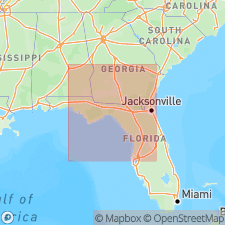
- Usage in publication:
-
- Tampa Member
- Modifications:
-
- Geochronologic dating
- AAPG geologic province:
-
- Florida platform
Summary:
Authors use 87Sr/86Sr isotopic analyses in an attempt to resolve age relations of fossiliferous marine units that contain the remains of terrestrial vertebrates. Tampa Member of the Arcadia Formation yielded a late Oligocene age of 25.4 Ma.
Source: GNU records (USGS DDS-6; Reston GNULEX).
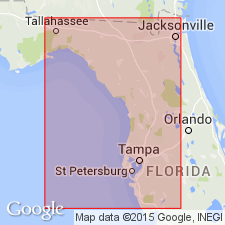
- Usage in publication:
-
- Tampa Member
- Modifications:
-
- Biostratigraphic dating
- AAPG geologic province:
-
- Florida platform
Summary:
Tampa Member at the base of the Arcadia Formation contains the Cow House Slough Local Fauna in Hillsborough Co., central FL. The Cow House Slough and the White Springs, found in the Parachucla, are both Arikareean in age. Consequently, the Tampa is at least in part late Oligocene and correlative with the Parachucla as suggested by Scott (1988). Upper part of the Arcadia contains the Sweetwater Branch and Bird Branch Local Faunas, which are Barstovian (Miocene).
Source: GNU records (USGS DDS-6; Reston GNULEX).
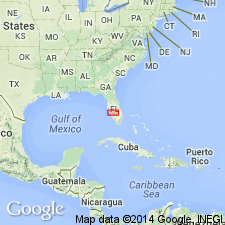
- Usage in publication:
-
- Tampa Member*
- Modifications:
-
- Age modified
- Biostratigraphic dating
- Geochronologic dating
- AAPG geologic province:
-
- Florida platform
Summary:
Authors follow usage of Scott (1988). Tampa and Nocatee Members are part of Arcadia Formation. Age of Tampa is late Oligocene to early Miocene based on molluscan data which indicate that Oligocene-Miocene boundary is crossed between 97.7 and 102.7 m depth in core W-16814. TURRITELLA cf. T. TARPONENSIS Mansfield 1937, found at 97.7 m, and TURRITELLA aff. T. PAGODAEFORMIS Heilprin, 1887, found at 97.8 m, resemble species generally considered to be early Miocene (Heilprin, 1887; Mansfield, 1937). TURRITELLA cf. T. TAMPAE Heilprin, 1887, was found from 100.6 to 101.5 m depth; T. TAMPAE has long been considered early Miocene based on its position in Tampa Member, but a revision of age of Tampa would lower its range into late Oligocene (agrees with observations of Ward, 1992, Molluscan biostratigraphy of the Miocene, middle Atlantic Coastal Plain of North America: Virginia Museum of Natural History Memoir 2, 159 p.). TURRITELLA cf. T BOWENAE Mansfield, 1937, was found at 103.0 m depth and is typical of "Suwannee" Limestone (Mansfield, 1937). TRIGONIOCARDIA sp. from 118.4 m brackets that sample as Oligocene or younger (Keen, 1969). The most definitive mollusc was TURRITELLA CAELATURA Conrad, 1848, found in samples from 197.9 to 200.9 m depth; this species has only been reported from early Oligocene (Vicksburgian) Mint Springs Formation of Mississippi (MacNeil and Dockery, 1984). Paleontologic samples of W-16814 agree with 87Sr/86Sr age estimates of 26.8 Ma (late Oligocene) for samples from 118.4 m depth, and 30.3 Ma (early Oligocene) for samples from 200.9 m depth.
Source: GNU records (USGS DDS-6; Reston GNULEX).
For more information, please contact Nancy Stamm, Geologic Names Committee Secretary.
Asterisk (*) indicates published by U.S. Geological Survey authors.
"No current usage" (†) implies that a name has been abandoned or has fallen into disuse. Former usage and, if known, replacement name given in parentheses ( ).
Slash (/) indicates name conflicts with nomenclatural guidelines (CSN, 1933; ACSN, 1961, 1970; NACSN, 1983, 2005, 2021). May be explained within brackets ([ ]).

